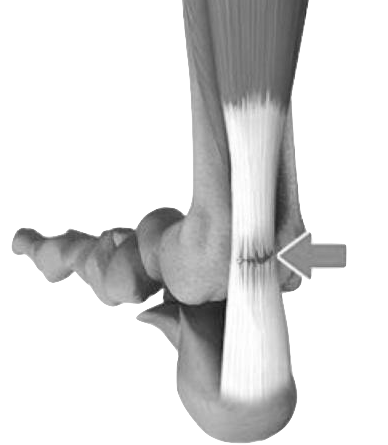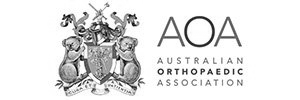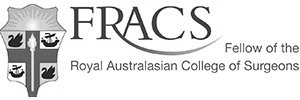Achilles Tendon Problems
What is the Achilles Tendon?
The Achilles Tendon is a band of soft but fibrous tissue that combine to form a strong tough cord.
This Achilles Tendon is one of the longest tendons in your body. It stretches from the heel bone to your calf muscles.
Contraction of the calf muscles tightens the Achilles Tendon and pulls the heel. This function enables the heel, foot and toe movements necessary for walking, running and jumping.
Types of Achilles Tendon Problems
Tendon problems or Tendinopathies, are also known as tendinitis or tendinosis common types include:
- Achilles Tendinosis - chronically damaged tendon with a loss of structure (disorganized, hard, thickened, scarred fibres with rubbery appearance)
- Achilles Tendinitis - acutely inflamed and swollen tendon that doesn't have microscopic tendon damage
- Achilles Tendon Rupture - tears (rupture) of tendon
- Achilles Paratenonitis - acute inflammation of the covering of the Achilles tendon
- Achilles Tendon Bursitis - also referred to as retrocalcaneal bursitis is the swelling of the bursa
| Phase | Name | Tendon Change | Prognosis |
|---|---|---|---|
| I | Reactive Tendinopathy | Normal Tissue Adaptation | Excellent - no or minimal treatment required |
| II | Tendon Dysrepair | Deminished load rate & Cell Loss | Good - Tendinopathy rehab program |
| III | Degenerative Tendinopathy | Deminished load rate & Cell Loss | Moderate - Tendinopathy rehab program |
| IV | Tendon Tear / Rupture | Tendon Tissue Breakdown | Loss of Function - surgery required |
About Achilles Tendinosis
Achilles Tendinosis is the degeneration of the Achilles tendon due to unresolved inflammation. The tendon develops minute tears or pores in the tissue, losing its unique structure. Sometimes, because of degeneration, an Achilles tendon also tears or ruptures partially or completely, causing pain or loss of movement.
About Achilles Tendinitis
Also referred to as Achilles tendinopathy is a common overuse injury and can be classified into two categories, these are
- Non-Insertional Achilles Tendinitis - acutely inflamed and swollen tendon that doesn't have microscopic tendon damage
- Insertional Achilles Tendinitis - degenerated tendon where it connects to the heel bone caused by exertion of force or repeated stress
Insertional Achilles Tendinitis commonly occurs in people between the ages of 40-50 years it is typically an overuse injury but also exacerbated by other inflammatory conditions that can be caused by: spondyloarthropathy, gout, psoriasis, Reiter’s syndrome, sarcoidosis, familial hyperlipidaemia, diffuse idiopathic skeletal hyperostosis and some medications such as steroids and certain antibiotics.
About Achilles Paratenonitis
Achilles Paratenonitis is also known as Achilles Peritendinitis, Tendovaginitis or Tenosynovitis. Achilles Paratenonitis can cause scarring that restricts the motion of the Achilles tendon but respond well to pain management. Achilles Paratenonitis occurs due to acute repeated straining of the Achilles tendon. The sheath becomes severely inflamed due to the overuse and becomes very painful.
About Achilles Tendon Bursitis
The retrocalcaneal bursa, a fluid-filled sac, which is located at the back of the heel under the Achilles tendon, contains a lubricating fluid that acts as a cushion to reduce friction between muscle and bones. Achilles tendon bursitis can occur in conjunction with Achilles Tendinitis or as a secondary injury associated with chronic conditions such as Plantar Fasciitis, Heel Spurs, Fibromyalgia and Rheumatoid arthritis.
About Achilles Tendon Rupture
The tear or rupture of the Achilles Tendon is commonly seen in middle-aged men and women who are involved in sports activities. People with a history of Tendonitis, and certain diseases such as Arthritis and Diabetes, are at higher risk for Achilles Tendon Rupture. Patients taking certain antibiotics can be more susceptible to ruptures.
What Causes Achilles Tendon Problems?
Common causes of Achilles Tendon Injuries include:
- Overuse - repetitive activities that exert excessive stress on the tendon and lead to micro-tears
- Foot Stressful Activities - participating in sports, exercises and occupation where pressure on the feet and ankles
- Footwear - improper shoes can also result in the rupture of the tendon.
- Obesity - places more strain on many parts of the body including the Achilles tendon
The Achilles Tendon Ruptures is a more severe Achilles Tendon problem and mainly occurs
- Middle-aged men and women who are involved in sports like running, pivoting and jumping like tennis, football, basketball and gymnastics
People with a history of tendonitis, and certain diseases such as arthritis and diabetes - Patients taking certain antibiotics can be more susceptible to rupture
Symptoms of Achilles Tendon Problems
Symptoms related to Achilles tendon disorders include:
- Swelling and bruising
- Mild tenderness at the back of the heel to severe pain (Rupture)
- Stiffness
- Loss of strength with decreased movement of the ankle
- Muscle weakness or tenderness
- Difficulty standing on tiptoe or pushing leg while walking
The pain gets worse with running, jumping and especially during sports activities.
A popping or snapping sound may be heard when an Achilles Rupture occurs.
How are Achilles Tendon Problems Diagnosed
Patients who suspect they have Achilles Tendon Problems require a fully diagnosis this can include:
Medical History
Your doctor will ask questions about:
- Current symptoms and what if any activities aggravate your condition, or how injury was sustained,
- Obtain a medical history including family or genetic links etc
- Determine any related former conditions diseases and treatments,
- Record health metrics (weight, mobility, blood pressure, heart rate, etc)
- Confirm medications, past and present
- Record habits, diet, exercise and other related actions
- Understand any risk factors or related complications or links
Physical Examination
Your doctor perform comprehensive physical evaluation that can include:
- Examining the affected area,
- Evaluate any swelling, pain, bruising or other features, etc
- Determine impact of condition such as range or motion, pain, diet, lifestyle,
- Record levels or severity of any symptoms
Diagnostic Testing
Once your doctor has completed the physical examination further tests maybe required. These tests can help your doctor determine or eliminate possible causes or impacts, or complete the diagnostic process and can include:
- Pathology - blood or other sample tests, lung functions, etc
- X-Ray -
- Ultrasound -
- Magnetic Resonance Imaging (MRI)
Once a final diagnosis has been completed your doctor can discuss with you and recommend any treatment options.
Non Surgical Treatment for Achilles Tendon Problems
Treatment for your condition can begin immediately and can include:
- Pain Medication - to treat pain or discomfort including nonsteroidal anti-inflammatory medications (NSAIDs) can relieve some
- Inflammation Medication - may be prescribed to alleviate swelling including antibiotics for infection control
- R.I.C.E. - To reduce the pain and swelling surrounding the injured area.
- Rest: Rest the affected area as more damage could result from putting pressure on the injury.
- Ice: Ice should be applied over a towel to the affected area
- Compression: Wrapping with an elastic bandage or an elasticated tubular bandage can help to minimize the swelling.
- Elevation: Elevating the injured area above heart level to help with any swelling and pain
- Exercise - may be recommended
- Bracing or Casting - may be recommended to brace
- Taping - may be applied over the affected areas to reduce pain.
- Orthotics - may be prescribed.
- Injection Therapies - may be prescribed to reduce inflammation and accelerate the healing of the patellar tendon.
- Platelet-Rich Plasma Therapy - may be prescribed to accelerate healing.
- Dry Needling - may be recommended to break up or destroy degenerative structures.
- Extracorporeal Shockwave Treatment - may be recommended help to stimulate regeneration to damaged or torn soft tissue.
Surgical Treatment for Achilles Tendon Problems
In cases where either a conservative treatment has not resolved the problem or where a patient best or only treatment option is surgery, your doctor may recommend:
- Achilles Tendon Tear Repair - To Repair, Debride, Reconstruct and or Lengthen the Tendon
- Bursectomy - a surgical procedure done to remove an inflamed or infected bursa.
What if Achilles Tendon Problems are Untreated?
If untreated
- Achilles Tendonitis can become a chronic condition leading to a series of tears that makes walking difficult and a tendon rupture likely
- Achilles Tendon Rupture a patient will find difficulty walking and suffer ongoing chronic pain
- Achilles Paratenonitis can aggravate the individual limit amount of running considerably
- Achilles Tendon Bursitis can lead to prolonged discomfort, tendon tears or rupture.
Prevention of Achilles Tendon Problems
To help prevent an Achilles Tendon injury, it is a good practice to
- Perform stretching exercises
- Warm-up exercises before participating in any exercises or sports activities.
- Increase the intensity and length of time of activity.
- Muscle conditioning helps to strengthen the muscles in the body.






